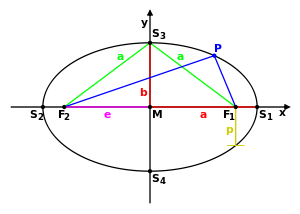Semi-major and semi-minor axes
The two characteristic radii of an ellipse are called semi-axes:
- The major semi-axis is half of the largest diameter of an ellipse, which is also called the major axis.
- The minor semi-axis is half of the shortest diameter (minor axis) and is exactly at a 90° angle to the major semi-axis.
The circle is a special ellipse where these two semi-axes are of equal length, in this case both semi-axes correspond to the radius of the circle.
The major axis (the largest diameter, here 

Parameters of an ellipse:
| S1,S2 | Main title | S3,S4 | Parting |
| | Main axis | | Minor axis |
| a | Large semi-axis | b | Small half-axis |
| F1,F2 | Focal point (ellipse) | e | lin. Eccentricity |
| M | Center | p | Parameter (semi-latus rectum) |
Astronomy
In astronomy, the major semimajor axis of a Keplerian orbit is one of the six so-called orbital elements and is often also inaccurately specified as "mean distance" and usually abbreviated as a. It characterizes - together with the eccentricity - the shape of elliptical orbits of various celestial bodies.
Such bodies are first of all the planets and their moons, artificial earth satellites, the asteroids and thousands of double stars.
According to Kepler's third law, the orbital period U of an elliptical orbit is coupled with a ( 
The two main vertices are called apsides, the main axis is the apside line: When a body lies at the focal point F1 and a smaller body orbits it on an ellipse, the shortest distance ( 

In the periapsis (pericenter, main vertex close to the gravicenter) the orbital velocity is maximal, in the apocenter minimal.
In addition to the major semimajor axis, the actual mean distance depends on the numerical eccentricity ε 
Geodesy
In geodesy, the axes of the so-called error ellipses are an important means of representing the mean or maximum/minimum point errors. In the adjustment of geodetic networks, the accuracy with which the individual survey points of the network are determined can be represented as an error ellipse.
Search within the encyclopedia

